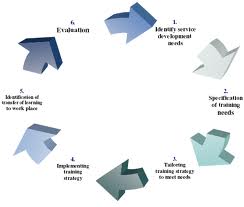Training processes is required to cover essential work-related skills, techniques and knowledge, and much of this section deals with taking a positive progressive approach to this sort of traditional ‘training’. After all the assessment they found that if they provide some facilities they the staffs could be very efficient and those facilities are:
On-the job training:
It’s a training which is operated at the sight of the company or training is carried out the working is running, it is really a effective process played by various well leading company and this system also played by the Nestle, but it is also a unavoidable risk because all new staffs can make a mistake or cause a loss to the company, therefore company plays that system when it’s right to do so. It is effective, when a major leveled employee do a mistake by mistakenly then, for making an improvement Nestle company plays that system.
Local training: these trainings are carried out within the country by reputed training institution from, Bangladesh slavery and labor training institute and consultant from foreign training institutes are invited to conduct training. These trainings are usually take place at a different venue other that the office.
In- house training: these trainings are basically held within the office premises and usually get conducted by the senior managers who are specialist in different field.
Training about the market survey: company plays a vital role in the market survey by sending their staff at market and operate a project by management to get the fluency and efficiency of the staffs.
Overseas training: company provides need based training to the employee through the usage of appropriate external training instate, which are very often conducted overseas. Most of the functional trainings are provided by foreign training.
Diversification training: it’s a process of training where staffs work at the different level and post of the management and identify the efficiency and effectiveness of their work ability.
Off-the job Training:
This process is also an effective training for internal staffs but it can be painful and fluctuate staff’s confidence and motivation, because it is quiet time consuming and costly which bared by company, but in may stages of the efficiency of a company or to make an efficient staff company may play this training. Where any temporary staff may work for the company with or without wages and this is actually not a job but binding for the staff to be full time staff, which is also depends on the performance of the staff.
Apprenticeship training: it is a process by which people become skilled worked through a combination of classroom instruction and on the job training . it is widely used to train individuals for many occupations. It traditionally involves having the learner apprentice study under the tutelage of a master crafts person.
Computer based training: now a day all most all companies provide training to their staffs by computers and projectors, this system is so much effective and time saving device. By this, companies can express their plans, training, what to do and what is restricted by company and other authorities; it is a total pack of direct communication and training process.
Training and development: some employees may have skills from their education or from previous jobs and therefore need little additional training. Others will need extensive training how much and kind of training is needed will depend on the type of job involved and the amount of training that has already been given through education and the coerces and the natural skills of the person employed. This section will be looking primarily at the type of training provided by organization to their employee.
















